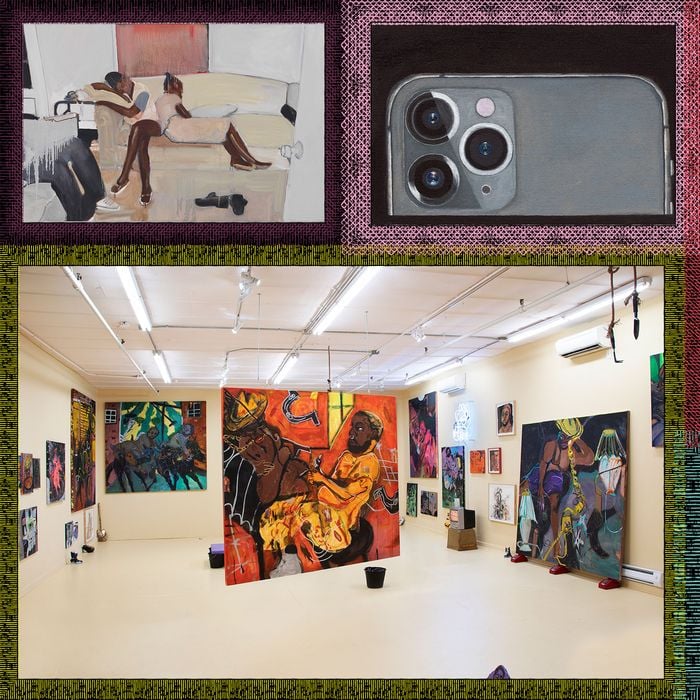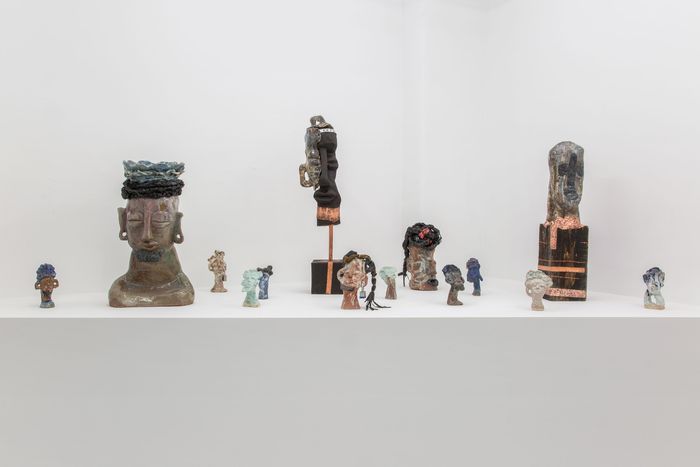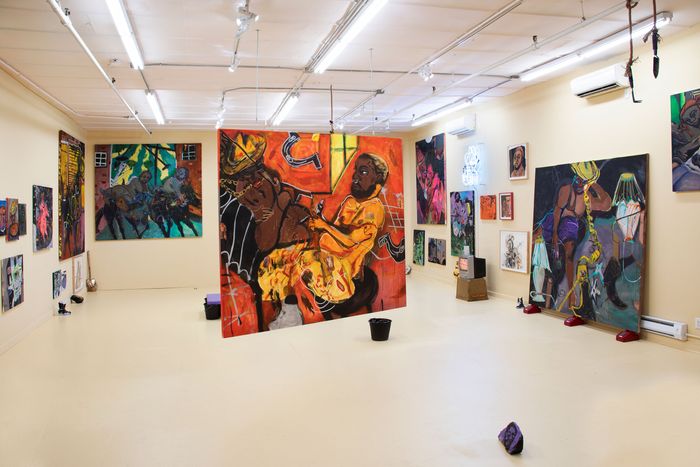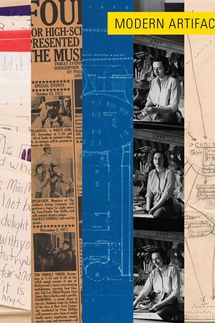Art
The 10 Best Art Shows of 2020 – Vulture

Pleasure is an important form of knowledge, and in art, pleasure comes from the bodily confirmation of seeing things in the flesh. That form of knowledge slipped away early this year. In our diminished physical spaces of quarantine, we could no longer take part in that ancient discourse of pleasure, and a pensive somnambulance set in. Then, in late May, the pressure of the pandemic was forcibly mixed with things that have lingered in the American night since our founding — and they exploded. The George Floyd protests initiated the next stage: Everyone went out again, all at the same time. We rediscovered one another. And something else too: the bodily confirmation of the town square, where activism could become a form of creativity.
This year reconfigured everything. Experiencing art in galleries and museums, being together, has taken on a new urgency, with added density and intensity. Nothing is neutral here. We’re now hyperaware that art lives in mutinous, contested space.
Our simplified daily lives, spent alone or in small groups, have mushroomed into a supercharged collective consciousness — one that will make our eventual return to communal space different. And, I think, better.
10. “Zoya Cherkassky: Lost Time” (Fort Gansevoort)
Online exhibitions got a lot of art lovers through this year. The best example I saw was organized by Alison M. Gingeras, one of the sharpest, most independent curators and critics out there. It was an exhibition of Kiev-born, Tel Aviv–based Cherkassky’s paintings of old-world Jews and Russians, punk kids, and scenes that conjure a high-tech interconnected shtetl. Mazel tov and l’chaim.
9. Tie: “Leilah Babirye: Ebika Bya ba Kuchu mu Buganda (Kuchu Clans of Buganda)” (Gordon Robichaux) and “Jonathan Lyndon Chase: Wind Rider” (Baby Company)


From top: Installation view of Leilah Babirye’s “Ebika Bya ba Kuchu mu Buganda (Kuchu Clans of Buganda).” Photo: Courtesy of Gordon Robichaux, NY. Photo: GregoryCarideoInstallation view of Jonathan Lyndon Chase’s “Wind Rider.” Photo: Courtesy of the artist and Company Gallery, New York
It makes sense that two of the best new artists should emerge at two of New York’s best new galleries. Babirye’s ceramic, wood, metal, and found-object sculptures pack power, material intelligence, spiritual wisdom, craziness, and an almost revolutionary -ancestral identity politics. Meanwhile, the shattered, recongealing figures in Chase’s paintings and sculptures alert us to a new shining star.
8. Michelle Elligott and Tod Lippy, ‘Modern Artifacts’ (Esopus Books)
This incredible book is a mad descent into the Museum of Modern Art’s archive — obsession become form. Elligott, MoMA’s chief of archives, library, and research collections, and the visionary publisher and folk artist Lippy present the museum’s wild history through facsimiles of all but lost documents, pictures, memos, notes, images, reviews, and secret messages. A new scriptorium of art.

7. Will Lord’s ‘Prehistoric Survival ‘Videos
Photo: Will Lord Prehistoric Survival/Youtube
This brilliant resident of East Anglia posts videos to Instagram and YouTube of himself wearing his own hand-hewn buckskins and bone-and-stone jewelry while making prehistoric-style artifacts — for example, flint axes carved from stone that Lord gathered himself. If I were a Netflix producer, I’d sign him for a series.
6. “Leidy Churchman, Earth Bound” (Matthew Marks)
Photo: Leidy Churchman, Courtesy Matthew Marks Gallery
This exhibition let me know what the universe would look like through a third eye. Churchman’s abstract and realistic citron-and-curry-colored paintings of pictures from books, the imagination, the internet, street scenes, and logos were like a walk-in encyclopedia allowing us to contact other worlds.
5. “Jonathan Berger: An Introduction to Nameless Love” (Participant Inc.)
Photo: Mark Waldhauser
Berger’s mystical installation swept me off my feet: a series of large nickel-wire scaffolds covered in thousands of one-inch-tall handcrafted letters spelling out visionary texts appropriated from artists, religious figures, designers, activists, and others. The effect was a temple of rhapsodic wisdom and pulsing prose. Sculptural poetry from a maker who deserves a MacArthur.
4. “Noah Davis” (David Zwirner)
Photo: Courtesy of The Estate of Noah Davis and David Zwirner. Photo: Kerry McFate
A thrilling discovery and a terrible loss. In this show organized by curator Helen Molesworth, Davis — who died in 2015 at age 32 — was revealed as a Degas-like painter of hushed intimacy. His images of people in parks, kitchens, and under the stars are clouded in secondary tones and washes that bring his work to ghostly eternal life.
3. “Souls Grown Diaspora” (Apexart)
Photo: Courtesy of apexart
This revelatory group show featured drawings, diagrams, paintings, sculptures, and altered found objects by mostly self-taught contemporary Black artists, all of them situated in a lineage shaped by the Great Migration. Gorgeous works of delight, life, and dilapidation.
2. “Jordan Casteel: Within Reach” (New Museum)
Photo: Courtesy the artist and Casey Kaplan, New York
This outstanding survey confirmed the 31-year-old Casteel as a major talent. A painter of modern life, she depicts mostly Black figures posed on building steps, at home, or elsewhere. This is a new level of charged and alive American social portraiture, one that doesn’t overfreight its subjects with struggle. Casteel’s paintings blaze in resinous, sensuous color.
1. Anything I Could See in Person
Photo: ANGELA WEISS/AFP via Getty Images
Galleries are my way of knowing the world. Seeing art in the flesh sustains me. Before the pandemic, I’d been seeing 25 shows a week, every week, since 1982. As with much else, the coronavirus stopped galleries in their tracks. Except for the profiteering auction houses and the multinational megagalleries that deplete the rest of the system of financial and critical oxygen, the art world held its breath. Many feared galleries could suffer a mass-extinction event.
Some did die — including one of the best, Gavin Brown’s Enterprise, whose proprietor shut down his own space to partner with Gladstone Gallery. Yet in September, when galleries began to open again in limited ways, it was clear that many had survived by doing just enough business online. (The fact that they didn’t have to shell out hundreds of thousands of dollars every month for art fairs helped too; ditto all the other travel and dinner expenses.) Returning to the galleries has been joyous. Masked visitors peer at the work through fogged glasses, and everyone beams, ecstatic to feel the collective buzz again and exchange bits of muffled conversation about this show, other shows, gossip, and art in general. These shared moments reassure us that New York’s high number and density of -contemporary-art galleries make it not just the trading floor for the art world but an artistic Garden of Eden. Long may the galleries thrive.
*A version of this article appears in the December 7, 2020, issue of New York Magazine. Subscribe Now!
More From This Series
Art
Calvin Lucyshyn: Vancouver Island Art Dealer Faces Fraud Charges After Police Seize Millions in Artwork

In a case that has sent shockwaves through the Vancouver Island art community, a local art dealer has been charged with one count of fraud over $5,000. Calvin Lucyshyn, the former operator of the now-closed Winchester Galleries in Oak Bay, faces the charge after police seized hundreds of artworks, valued in the tens of millions of dollars, from various storage sites in the Greater Victoria area.
Alleged Fraud Scheme
Police allege that Lucyshyn had been taking valuable art from members of the public under the guise of appraising or consigning the pieces for sale, only to cut off all communication with the owners. This investigation began in April 2022, when police received a complaint from an individual who had provided four paintings to Lucyshyn, including three works by renowned British Columbia artist Emily Carr, and had not received any updates on their sale.
Further investigation by the Saanich Police Department revealed that this was not an isolated incident. Detectives found other alleged victims who had similar experiences with Winchester Galleries, leading police to execute search warrants at three separate storage locations across Greater Victoria.
Massive Seizure of Artworks
In what has become one of the largest art fraud investigations in recent Canadian history, authorities seized approximately 1,100 pieces of art, including more than 600 pieces from a storage site in Saanich, over 300 in Langford, and more than 100 in Oak Bay. Some of the more valuable pieces, according to police, were estimated to be worth $85,000 each.
Lucyshyn was arrested on April 21, 2022, but was later released from custody. In May 2024, a fraud charge was formally laid against him.
Artwork Returned, but Some Remain Unclaimed
In a statement released on Monday, the Saanich Police Department confirmed that 1,050 of the seized artworks have been returned to their rightful owners. However, several pieces remain unclaimed, and police continue their efforts to track down the owners of these works.
Court Proceedings Ongoing
The criminal charge against Lucyshyn has not yet been tested in court, and he has publicly stated his intention to defend himself against any pending allegations. His next court appearance is scheduled for September 10, 2024.
Impact on the Local Art Community
The news of Lucyshyn’s alleged fraud has deeply affected Vancouver Island’s art community, particularly collectors, galleries, and artists who may have been impacted by the gallery’s operations. With high-value pieces from artists like Emily Carr involved, the case underscores the vulnerabilities that can exist in art transactions.
For many art collectors, the investigation has raised concerns about the potential for fraud in the art world, particularly when it comes to dealing with private galleries and dealers. The seizure of such a vast collection of artworks has also led to questions about the management and oversight of valuable art pieces, as well as the importance of transparency and trust in the industry.
As the case continues to unfold in court, it will likely serve as a cautionary tale for collectors and galleries alike, highlighting the need for due diligence in the sale and appraisal of high-value artworks.
While much of the seized artwork has been returned, the full scale of the alleged fraud is still being unraveled. Lucyshyn’s upcoming court appearances will be closely watched, not only by the legal community but also by the wider art world, as it navigates the fallout from one of Canada’s most significant art fraud cases in recent memory.
Art collectors and individuals who believe they may have been affected by this case are encouraged to contact the Saanich Police Department to inquire about any unclaimed pieces. Additionally, the case serves as a reminder for anyone involved in high-value art transactions to work with reputable dealers and to keep thorough documentation of all transactions.
As with any investment, whether in art or other ventures, it is crucial to be cautious and informed. Art fraud can devastate personal collections and finances, but by taking steps to verify authenticity, provenance, and the reputation of dealers, collectors can help safeguard their valuable pieces.
Art
Ukrainian sells art in Essex while stuck in a warzone – BBC.com
[unable to retrieve full-text content]
Ukrainian sells art in Essex while stuck in a warzone BBC.com

Source link
Art
Somerset House Fire: Courtauld Gallery Reopens, Rest of Landmark Closed
The Courtauld Gallery at Somerset House has reopened its doors to the public after a fire swept through the historic building in central London. While the gallery has resumed operations, the rest of the iconic site remains closed “until further notice.”
On Saturday, approximately 125 firefighters were called to the scene to battle the blaze, which sent smoke billowing across the city. Fortunately, the fire occurred in a part of the building not housing valuable artworks, and no injuries were reported. Authorities are still investigating the cause of the fire.
Despite the disruption, art lovers queued outside the gallery before it reopened at 10:00 BST on Sunday. One visitor expressed his relief, saying, “I was sad to see the fire, but I’m relieved the art is safe.”
The Clark family, visiting London from Washington state, USA, had a unique perspective on the incident. While sightseeing on the London Eye, they watched as firefighters tackled the flames. Paul Clark, accompanied by his wife Jiorgia and their four children, shared their concern for the safety of the artwork inside Somerset House. “It was sad to see,” Mr. Clark told the BBC. As a fan of Vincent Van Gogh, he was particularly relieved to learn that the painter’s famous Self-Portrait with Bandaged Ear had not been affected by the fire.
Blaze in the West Wing
The fire broke out around midday on Saturday in the west wing of Somerset House, a section of the building primarily used for offices and storage. Jonathan Reekie, director of Somerset House Trust, assured the public that “no valuable artefacts or artworks” were located in that part of the building. By Sunday, fire engines were still stationed outside as investigations into the fire’s origin continued.
About Somerset House
Located on the Strand in central London, Somerset House is a prominent arts venue with a rich history dating back to the Georgian era. Built on the site of a former Tudor palace, the complex is known for its iconic courtyard and is home to the Courtauld Gallery. The gallery houses a prestigious collection from the Samuel Courtauld Trust, showcasing masterpieces from the Middle Ages to the 20th century. Among the notable works are pieces by impressionist legends such as Edouard Manet, Claude Monet, Paul Cézanne, and Vincent Van Gogh.
Somerset House regularly hosts cultural exhibitions and public events, including its popular winter ice skating sessions in the courtyard. However, for now, the venue remains partially closed as authorities ensure the safety of the site following the fire.
Art lovers and the Somerset House community can take solace in knowing that the invaluable collection remains unharmed, and the Courtauld Gallery continues to welcome visitors, offering a reprieve amid the disruption.
-

 Sports20 hours ago
Sports20 hours agoArmstrong scores, surging Vancouver Whitecaps beat slumping San Jose Earthquakes 2-0
-

 News20 hours ago
News20 hours agoAs plant-based milk becomes more popular, brands look for new ways to compete
-

 News17 hours ago
News17 hours agoLabour Minister praises Air Canada, pilots union for avoiding disruptive strike
-

 News2 hours ago
News2 hours agoNova Scotia premier repeats calls for Ottawa to pay for protecting Chignecto Isthmus
-

 News2 hours ago
News2 hours agoEmir of Qatar to visit Ottawa on what will be his first official trip to Canada
-

 News2 hours ago
News2 hours agoTIFF audience prizes for ‘Life of Chuck,’ Hip doc; Rankin among Canadian winners
-

 News17 hours ago
News17 hours agoLooking for the next mystery bestseller? This crime bookstore can solve the case
-

 News20 hours ago
News20 hours agoInflation expected to ease to 2.1%, lowest level since March 2021: economists





















